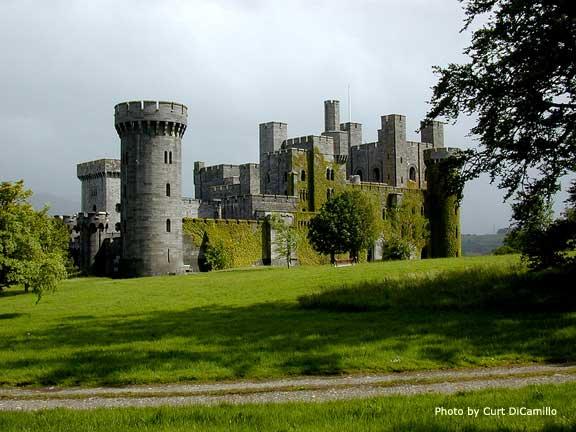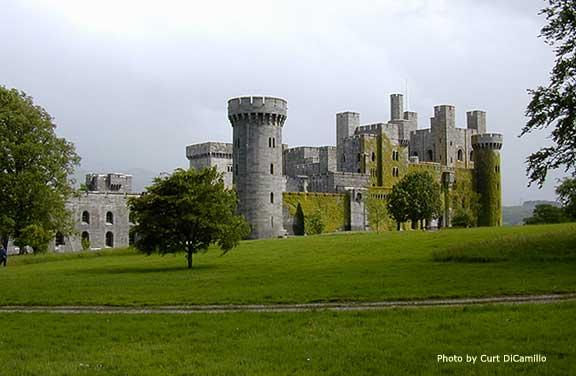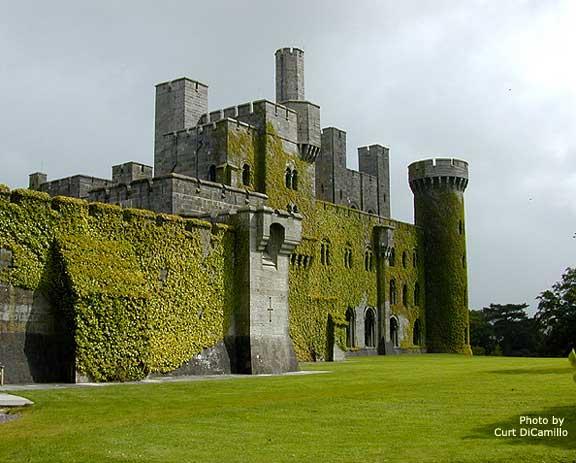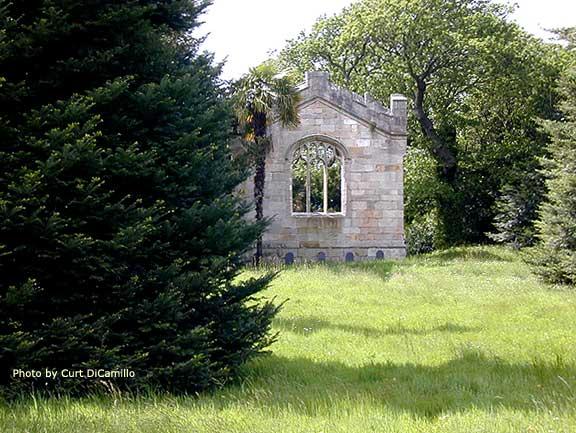



Fragment from Medieval Chapel
House & Family History: Penrhyn began life in the 14th century as a fortified medieval manor house. A license to crenellate was granted between 1410 and 1431; then, 350 years later, Samuel Wyatt remodeled and rebuilt the house in the 1780s in the Gothick style. When the current, enormous Penrhyn Castle was built in the 19th century, the great hall of the earlier house was incorporated into the drawing room. This huge rebuilding was funded by the Pennant family's vast wealth, which derived from slaves, Jamaican sugar plantations, and Welsh slate quarries, the latter of which were the largest in the world by the mid-19th century. At their peak in the 1860s the slate quarries were producing a net income of £100,000 per year (equivalent to approximately £65 million in 2016 inflation-adjusted values using the labour value commodity index), making the Pennant family enormously wealthy. George Hay Dawkins-Pennant, nephew of the discoverer of Palmyra, and first cousin once removed of Richard Pennant (later Lord Penrhyn, who founded the family fortunes), inherited the Penrhyn Estate in 1816 (which was when he appended the Pennant name to his surname). Upon inheriting this enormous income-producing property, Dawkins-Pennant hired the architect Thomas Hopper to rebuild the house, famously telling Hopper that there was no limit on cost (the house cost about £150,000, approximately £116 million in 2016 values). Hopper rose to the occasion and created a fantastic Norman-style castle on an immense scale. "Proper" Norman staircases were invented (Normans had circular staircases; thus, the architect created what he thought a Norman grand staircase should look like) and Norman-style furniture, paneling, and plasterwork designed and installed in the new house. The result is the largest castle in the British Isles, after Windsor Castle, stretching on for 600 feet. The house, together with 40,000 acres, was given to the National Trust in 1951.
Collections: Penrhyn houses one of the most important collections of paintings in Wales, including works by Richard Wilson, Perino del Vaga, Canaletto, Palma Vecchio, Carl Haag, and Rembrandt; the latter's "Catrina Hooghsaet" was almost sold to the Dutch Culture Ministry in 2007 for the Rijksmuseum, but the Dutch government couldn't meet the price, which was supposedly in the neighborhood of £40 million. "St. Luke Drawing the Virgin and Child," a 15th century devotional painting attributed to the workshop of the Netherlandish artist Dieric Bouts the Elder, was sold to a foreign buyer in November of 2015; however, the UK government put a temporary export ban on the painting leaving Britain in the hope that an individual or a gallery in Britain would match the asking price of £3.3 million. The culture minister, Ed Vaizey, said: "This distinctive painting is the only example of St. Luke drawing the Virgin Mary and Christ by a northern European artist on display in this country. I hope that a buyer comes forward to save this iconic piece for the UK." In July of 2016 the painting was ultimately saved for the nation. The Bowes Museum in County Durham paid £2.3 million (the Heritage Lottery Fund contributed £1.99 million) for the privately owned painting that had been in collection at Penrhyn. Penrhyn Castle also contains the famous bed manufactured from slate from the Penrhyn quarries (it weighs over a ton) that was made for Queen Victoria's 1859 visit to Penrhyn (the queen refused to sleep in the bed because it reminded her of a tombstone).
Garden & Outbuildings: The estate contains a countryside exhibition, an industrial railway museum, a large tree and shrub collection, and a Victorian terraced walled garden.
Architect: Samuel Wyatt
Date: 1780sArchitect: Thomas Hopper
Date: 1820-37John Bernard (J.B.) Burke, published under the title of A Visitation of the Seats and Arms of the Noblemen and Gentlemen of Great Britain and Ireland, among other titles: Vol. I, p. 80, 1852.
Country Life: II, 377, 1897. CXVIII, 80 plan, 140 plan, 192, 1956.
Title: Biographical Dictionary of British Architects, 1600-1840, A - HARDBACK
Author: Colvin, Howard
Year Published: 2008
Reference: pgs. 542, 1195
Publisher: New Haven: Yale University Press
ISBN: 9780300125085
Book Type: Hardback
Title: In Trust for the Nation: Paintings from National Trust Houses
Author: Laing, Alastair
Year Published: 1995
Reference: pgs. 94-95
Publisher: London: The National Trust
ISBN: 070801958
Book Type: Softback
House Listed: Grade I
Park Listed: Not Listed
Past Seat / Home of: Ednyfed Fychan, 13th century. Richard Pennant, 1st Baron Penrhyn, 18th century; George Hay Dawkins-Pennant, 19th century; Hugh Napier Douglas-Pennant, 4th Baron Penrhyn, 20th century; Lady Janet Pelham, 20th century; Pennant family here until 1951.
Current Ownership Type: The National Trust
Primary Current Ownership Use: Visitor Attraction
House Open to Public: Yes
Phone: 01248-353-084
Fax: 01248-371-281
Email: [email protected]
Website: https://www.nationaltrust.org.uk
Historic Houses Member: No